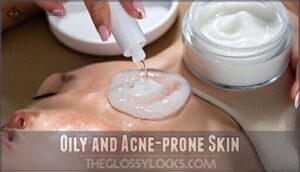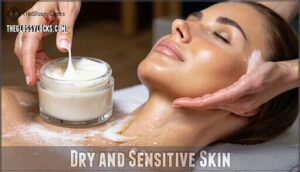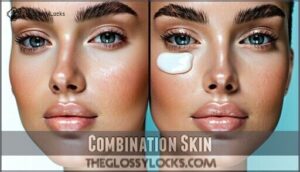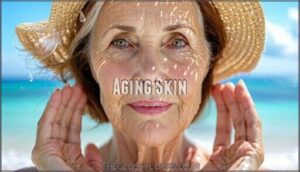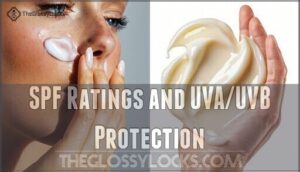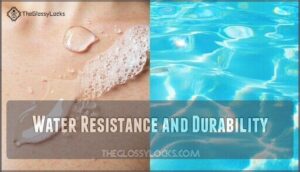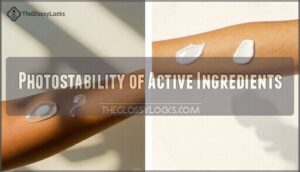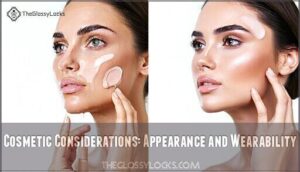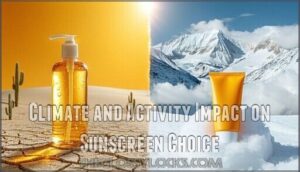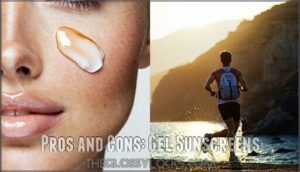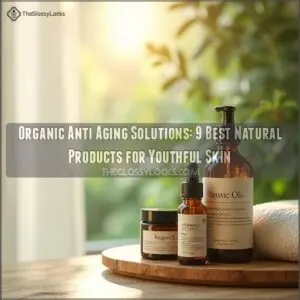This site is supported by our readers. We may earn a commission, at no cost to you, if you purchase through links.
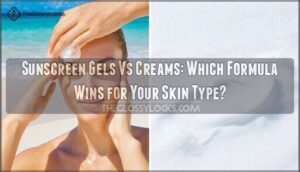 Your skin type determines the winner in the sunscreen gels vs creams debate.
Your skin type determines the winner in the sunscreen gels vs creams debate.
Gels work best for oily, acne-prone skin because they absorb quickly without clogging pores or leaving greasy residue.
They’re also perfect for humid climates where heavy creams feel suffocating.
Creams, however, shine for dry or sensitive skin, providing extra moisture and longer-lasting protection.
They’re ideal for cold weather when your skin needs hydration.
Combination skin? You might benefit from using both – gel on your T-zone, cream on drier areas.
The secret lies in understanding how different formulations interact with your unique skin needs, and finding the right balance for your skin type and unique skin needs.
Table Of Contents
- Key Takeaways
- Understanding Sunscreen Gels and Creams: Key Differences
- Skin Types: Choosing Between Gel and Cream Sunscreens
- Sun Protection Factors: Gel Vs Cream Effectiveness
- Cosmetic Considerations: Appearance and Wearability
- Climate and Activity Impact on Sunscreen Choice
- Pros and Cons: Gel Sunscreens
- Pros and Cons: Cream Sunscreens
- Combining Gel and Cream Sunscreens for Optimal Protection
- Frequently Asked Questions (FAQs)
- What is the difference between gel and cream sunscreen?
- Should I use gel or cream sunscreen?
- Do cream sunscreens make a difference?
- Are gel based sunscreens good for acne?
- What is the difference between a sunscreen cream and a spray?
- What is the difference between water based and gel based sunscreen?
- What is better, sunscreen gel or cream?
- Which is better gel or cream?
- What is the difference between sunblock cream and gel?
- Are gel sunscreens effective?
- Conclusion
Key Takeaways
- Match your sunscreen to your skin type – Choose gel if you’ve got oily or acne-prone skin since it absorbs quickly without clogging pores, or pick cream if your skin’s dry and needs extra moisture along with protection
- Consider your climate and activities – You’ll want lightweight gels in hot, humid weather or during workouts, while cream sunscreens work better in cold, dry conditions or for extended outdoor exposure
- Both formulas protect equally well – Don’t worry about protection differences since gel and cream sunscreens offer identical SPF ratings and UV coverage when you apply them properly and reapply every two hours
- You can use both strategically – Apply gel to your oily T-zone and cream to drier areas like cheeks, or switch between formulas seasonally to match your skin’s changing needs throughout the year
Understanding Sunscreen Gels and Creams: Key Differences
When you’re standing in the sunscreen aisle, you’ll notice gel and cream formulas look and feel completely different.
Gels offer a lightweight, water-based texture that absorbs quickly, while creams provide a thicker, oil-based consistency that takes longer to blend into your skin, offering a distinct choice in terms of texture.
Texture and Consistency
When choosing between gel vs cream sunscreen, texture plays a vital role in your daily routine.
Gel lightweightness creates a water-like consistency that spreads effortlessly, while cream thickness provides a rich, emollient feel.
Here’s what you’ll notice:
- Gel texture: Flows like liquid, absorbs instantly without residue differences
- Cream texture: Spreads like moisturizer, takes time to blend completely
- Consistency: Gels feel weightless, creams provide substantial coverage
Your skin feel preference determines which sunscreen gel texture or sunscreen cream texture works best for you.
Absorption Rate and Skin Feel
Sunscreen absorption speed varies dramatically between formulations.
Gel sunscreens absorb within seconds, creating a weightless feel without greasy residue.
Looking at the paragraph about gel sunscreens and the overall tone of the content, here’s a short, engaging blockquote:
Instant absorption meets weightless protection—gel sunscreens deliver comfort without compromise.
Their matte finish makes them ideal for oily skin types seeking quick absorption.
Cream sunscreens take longer to absorb due to their thicker sunscreen cream texture, providing enhanced hydration levels but potentially leaving a dewier finish.
| Feature | Gel Sunscreen | Cream Sunscreen |
|---|---|---|
| Absorption Rate | Fast (seconds) | Slow (minutes) |
| Skin Feel | Lightweight, matte | Rich, moisturizing |
| Residue | Minimal to none | Possible greasy feel |
The sunscreen gel texture delivers immediate comfort, while cream formulations offer lasting moisture protection for different skin needs.
For those with sensitive skin, consider options with mineral based ingredients, which provide enhanced hydration and a weightless feel, making them suitable for oily skin types and offering a matte finish with minimal residue.
Ingredients and Formulation
The chemistry behind these formulations reveals distinct pathways to sun protection. Active ingredients like avobenzone and octinoxate appear in both formats, but their supporting cast differs substantially.
Sunscreen gel relies on water-based formulations with minimal emollients presence, creating lightweight protection through:
- Alcohol-based carriers for rapid evaporation
- Silicone usage for smooth application without heaviness
- Carbomers providing formula stability in clear matrices
Sunscreen cream takes a different approach with oil-water emulsions. Higher water content blends with fatty alcohols and glyceryl stearate, while UV filters sit within richer bases. This creates thicker consistency but enhanced moisturizing properties.
Both formats use identical sun protection technology—it’s the delivery system that sets them apart. The manufacturing process involves emulsification under controlled conditions to blend oil and water phases.
Application Methods
While gel sunscreens glide on effortlessly with quick absorption, cream sunscreens require more patience and thorough rubbing.
Apply gel formulas using gentle patting motions for even coverage, especially on specific areas like your face.
Cream consistency demands circular massaging until no white residue remains.
Both textures need proper application amount—about a teaspoon per body part—and consistent reapplication timing every two hours, regardless of application tools used, to ensure even coverage.
Skin Types: Choosing Between Gel and Cream Sunscreens
Your skin type determines which sunscreen formula works best for your daily protection needs.
Understanding how gel and cream sunscreens interact with different skin types helps you make the right choice for effective, comfortable sun protection.
Oily and Acne-prone Skin
When your face produces enough oil to fry an egg, choosing sunscreen gel over cream becomes essential for oil control and pore clogging prevention.
Gel formulas work like a lightweight shield, absorbing quickly without triggering acne or ingredient sensitivity issues.
Here’s why gel sunscreens win for acneprone skin:
- Noncomedogenic formula prevents pore blockages
- Water-based texture controls excess oil production
- Quick absorption eliminates greasy residue
- Matte finish reduces unwanted shine
- Gentle ingredients minimize acne triggers
Unlike heavy creams that can worsen breakouts, sunscreen gel provides protection without compromising your skin’s balance or increasing scar prevention concerns.
For oily skin, a gel sunscreen’s non-greasy properties make it a preferable choice.
Dry and Sensitive Skin
When dealing with dry skin or sensitive skin conditions, sunscreen cream emerges as the clear winner.
Dry skin craves the rich, protective embrace that only cream sunscreens can deliver.
These formulations deliver superior hydration levels and barrier repair benefits compared to sunscreen gel options.
Cream benefits include rich emollients that prevent skin irritation while providing essential moisture.
You can find a sunscreen cream dry to help with this.
Unlike gels that may cause gel irritation through alcohol content, creams minimize ingredient sensitivity concerns for delicate complexions.
Combination Skin
Managing combination skin means balancing opposing needs across your face.
Apply lightweight sunscreen gel to your T-zone for oil control, while using hydrating sunscreen cream on drier cheek areas.
This product layering approach prevents oily zones from becoming greasy while providing adequate cheek hydration.
Consider seasonal changes too—you might need more cream during winter months when dry areas become even drier.
For maximum protection, make certain you’re using a broad-spectrum sunscreen for broad-spectrum protection, and apply it to achieve maximum protection, considering the seasonal changes, and using the right sunscreen cream.
Aging Skin
Why shouldn’t aging skin settle for basic protection when it deserves premium care? As skin matures, sun damage accelerates wrinkles and fine lines, making proper sunscreen selection vital for wrinkle prevention.
- Sunscreen cream provides essential hydration importance with moisturizing ingredients
- Antioxidant protection helps combat free radicals that accelerate skin aging
- Higher SPF formulas offer enhanced defense against further damage
While sunscreen gel absorbs quickly, cream formulations typically deliver superior moisturizing benefits for mature skin’s collagen boost needs.
Sun Protection Factors: Gel Vs Cream Effectiveness
In terms of actual sun protection, you’ll find that both gel and cream sunscreens can deliver identical SPF ratings and broad-spectrum coverage against harmful UVA and UVB rays.
The real difference lies in how well each formula stays put on your skin during daily activities, with water resistance and reapplication needs varying based on the specific product formulation rather than whether it’s a gel or cream, which affects the overall broad-spectrum coverage.
SPF Ratings and UVA/UVB Protection
Protection matters most when choosing between sunscreen gel and sunscreen cream.
Both formulations deliver identical SPF efficacy and broad spectrum coverage when properly applied. Your skin receives the same UVA protection and UVB penetration defense regardless of texture choice.
| Protection Factor | Gel Formula | Cream Formula |
|---|---|---|
| SPF Ratings | 15-100+ available | 15-100+ available |
| UVA Coverage | Broad spectrum options | Broad spectrum options |
| UVB Defense | Equal protection levels | Equal protection levels |
| Active Ingredients | Same UV filters used | Same UV filters used |
The key lies in consistent SPF reapplication every two hours, not formula type. Choose based on your skin’s needs while maintaining proper application habits for maximum sun safety.
Water Resistance and Durability
Most sunscreens today offer decent water resistance, but neither gel nor cream formulas are truly waterproof.
Gel sunscreens typically get washed away faster by water and sweat, requiring more frequent reapplication. Cream sunscreens often provide better staying power thanks to their thicker consistency and enhanced formula stability.
| Factor | Gel Sunscreen | Cream Sunscreen |
|---|---|---|
| Water Resistance | Moderate, easily removed | Better adherence to skin |
| Sweat Resistance | Lower, needs frequent touch-ups | Higher, lasts longer during activity |
| Formula Stability | Good in humid climates | Superior overall durability |
| Climate Impact | Performs well in hot weather | Excels in varied conditions |
Your activity levels and environment should guide your choice—gels work great for quick outdoor activities, while creams handle extended exposure better.
Reapplication Frequency
While water resistance matters, both sunscreen gel and sunscreen cream require consistent reapplication for maximum protection.
Your reapplication schedule depends on several factors that directly impact how often you’ll need to refresh your coverage.
| Reapplication Trigger | Recommended Frequency |
|---|---|
| General sun exposure | Every 2 hours |
| Swimming or water activities | Immediately after |
| Heavy sweating/sports | Every 60-90 minutes |
| Toweling off | Right away |
Activity Influence plays a major role in determining ideal intervals.
Environmental factors like wind and humidity affect how quickly your sunscreen wears off.
Formulation impact means gel textures may require more frequent touch-ups than cream consistency due to easier removal by sweat.
User compliance improves when you set phone reminders and keep extra sunscreen handy.
Photostability of Active Ingredients
Your sunscreen’s effectiveness depends on how well its UV filters withstand sun exposure.
Photostability varies between formulations—some ingredients break down faster than others.
| Formulation | Photostability |
|---|---|
| Gel-based | Generally higher due to alcohol content |
| Cream-based | Moderate, depends on stabilizers |
| Avobenzone blends | Requires encapsulation technology |
| Mineral filters | Most stable against UV radiation |
Understanding UV filter degradation helps you choose products with better ingredient synergies and stability testing results for reliable protection.
Cosmetic Considerations: Appearance and Wearability
Your sunscreen choice affects more than just protection—it shapes how you look and feel throughout the day.
The right formula can make or break your makeup routine, control shine, and help you avoid that telltale white cast that screams "I’m wearing sunscreen" with a telltale presence.
White Cast and Visible Residue
Nobody wants to look like they’ve been dusted with flour after applying sunscreen. White cast becomes particularly noticeable on darker skin tones, making ingredient transparency and application techniques critical for consumer perception.
- Sunscreen gel formulations absorb quickly without leaving visible residue, thanks to their water-based consistency
- Mineral sunscreen options now include micronized particles that blend seamlessly across all skin tones
- Proper application techniques involve warming the product between your hands before gentle patting motions
- Sunscreen cream texture requires extra blending time but offers better coverage for those who master the technique
Makeup Compatibility
Gel formulations excel with makeup thanks to primer pairing and quick absorption.
Your foundation texture stays smooth when applied over non-greasy gels, while cream sunscreens may disrupt makeup longevity.
For best results, wait fifteen minutes after sunscreen application. Gel sunscreens provide an ideal matte finish base, preventing foundation from sliding off throughout the day, which is a key factor in maintaining a smooth makeup longevity.
Shine Control and Matte Finish
Fighting shine all day? Three simple facts make gel sunscreens your secret weapon for staying matte.
Gel advantages include lightweight formulas that absorb instantly, while cream drawbacks often involve lingering greasiness throughout the day.
For oily skin types, sunscreen gel delivers superior shine control compared to sunscreen cream’s heavier texture.
Here’s what makes gel formulas shine-stopping champions:
- Quick absorption prevents surface buildup that causes greasiness
- Oil-free base won’t add extra shine to already oily skin
- Mattifying ingredients actively control excess sebum production
- Lightweight feel maintains matte finish for hours without reapplication
- Makeup application stays smooth since gel won’t pill or separate
The matte finish from gel formulations lasts substantially longer than cream alternatives, making them ideal for controlling shine duration.
Tinted Options for Both Gels and Creams
Tinted sunscreen options bring makeup and protection together in one step. Sunscreen gel formulas offer sheer coverage with lightweight finish options, while sunscreen cream versions provide fuller coverage level for your skin tone.
Shade matching becomes essential – test products to find your perfect match. You can easily find a tinted sunscreen online.
Both gel and cream tinted sunscreen formulas maintain ingredient safety standards while complementing your skin type and daily makeup routine.
Climate and Activity Impact on Sunscreen Choice
Your environment plays a vital role in determining whether gel or cream sunscreen works best for your lifestyle and activities.
Hot, humid weather calls for lightweight gel formulas that won’t feel sticky or clog pores, while cold, dry climates benefit from cream sunscreens that provide extra moisture and protection.
Hot and Humid Environments
Sweat and sunscreen don’t mix well in tropical climates, where humidity’s impact makes gel formulas your go-to choice.
Unlike cream sunscreen, sunscreen gel absorbs quickly without adding grease to already sticky skin, preventing heat rash while maintaining protection.
- Quick absorption: Gel sunscreen won’t sit on your skin like cream in humid climate conditions
- Sweat resistance: Less likely to slide off when you’re perspiring heavily
- Frequent sunscreen reapplication: Lightweight feel makes reapplying throughout the day more comfortable
Cold and Dry Climates
Battling harsh winter conditions requires strategic sunscreen choices that address both Dryness Protection and Hydration Needs.
In cold climate environments, your skin faces dual challenges from UV exposure and moisture loss. Cream Preference becomes essential during winter months, as these formulations provide superior Climate Effects management compared to gel alternatives.
Here’s why Winter Sunscreen in cream form excels:
- Moisturizing sunscreen cream delivers dual-action protection, combining UV defense with essential hydration for dry skin
- Sunscreen cream creates a protective barrier against wind and cold while maintaining skin moisture
- Cold climate formulations resist freezing and separation, ensuring consistent application and effectiveness throughout harsh weather conditions
Water Activities and Swimming
Water activities demand serious sunscreen protection, but choosing between gel and cream formulas can make or break your aquatic adventures.
Sunscreen gel absorbs quickly yet requires frequent reapplication after swimming due to reduced water-resistant properties.
Sunscreen cream offers superior chlorine resistance and saltwater effects protection, maintaining SPF longer underwater.
Neither formula is truly waterproof—reapplication importance remains critical every 80 minutes during water exposure.
Check sunscreen ingredients and water-resistant claims before diving in.
Outdoor Sports and Heavy Sweating
While engaging in outdoor sports, your sunscreen choice becomes essential as heavy sweating challenges even the best formulas.
Gel sunscreen advantages shine here with superior sweat resistance and lighter feel, while cream drawbacks include greasiness that compounds with perspiration.
Athlete preferences consistently favor gels for their non-slip texture and quick absorption.
For those with sensitive skin, consider options with mineral sunscreen ingredients.
- Feel confident knowing your protection won’t slide off mid-game
- Enjoy lightweight comfort that moves with your body’s every motion
- Experience peace of mind with reliable coverage during intense activities
Reapplication urgency remains critical every hour during heavy sweating, regardless of gel superiority over traditional creams.
Pros and Cons: Gel Sunscreens
Gel sunscreens offer several advantages that make them a popular choice for many skin types.
They also come with some limitations you should consider.
Understanding these pros and cons will help you determine if gel formulas align with your specific skincare needs and lifestyle preferences, considering the overall lifestyle.
Lightweight Feel and Quick Absorption
Gel sunscreens deliver Fast Absorption that’ll surprise you – they disappear into your skin within seconds.
You’ll experience a Non-Greasy Feel that makes Summer Comfort achievable, even during scorching days.
The lightweight texture supports Makeup Layering without pilling or sliding.
Perfect for your Active Lifestyle, these formulas won’t weigh you down during workouts or outdoor adventures.
| Feature | Gel Sunscreen | Cream Sunscreen |
|---|---|---|
| Absorption Time | 10-30 seconds | 2-5 minutes |
| Skin Feel | Weightless, invisible | Noticeable layer |
| Makeup Compatibility | Excellent base | May cause separation |
| Exercise Performance | Won’t budge during sweat | Can feel heavy |
| Reapplication Ease | Quick, mess-free | Requires blending |
Non-comedogenic Properties
Beyond quick absorption, gel sunscreens excel with their noncomedogenic properties.
These formulas won’t clog your pores, making them perfect for acne prevention and oil control.
Unlike heavy creams with pore-clogging ingredients, sunscreen gel offers superior skin health benefits through careful ingredient analysis.
This comedogenicity advantage makes gel the clear winner for sunscreen for oily skin, protecting without triggering breakouts.
Potential for Alcohol Content
Gel sunscreen’s alcohol content creates a trade-off you’ll want to understand.
Volatile alcohol types like ethanol provide quick absorption but can trigger drying effects on sensitive skin.
Here’s the breakdown:
- Fast-drying finish: Alcohol evaporates quickly for lightweight feel
- Barrier disruption: Higher concentrations may compromise skin protection
- Formulation stability: Alcohol helps preserve gel consistency
- Regulatory limits: Most products stay within safe concentration ranges
Suitability for Body and Facial Use
Alcohol-based formulas aside, gel sunscreen excels for both body coverage and facial sensitivity.
You’ll find gel sunscreen for face absorbs quickly without clogging pores, making it perfect for oily skin concerns.
The lightweight formula spreads effortlessly across large body areas, while specific needs like acne-prone zones benefit from its non-comedogenic properties.
For daily defense, broad-spectrum protection is essential.
Unlike sunscreen cream, gels won’t leave you feeling sticky or greasy regardless of application area.
Pros and Cons: Cream Sunscreens
Cream sunscreens offer rich, moisturizing formulas that work well for dry and sensitive skin types, though they come with trade-offs you’ll want to keep in mind.
While they provide excellent hydration and longer-lasting protection, their thicker texture can feel greasy and may leave a white cast on darker skin tones, which is a significant consideration for sensitive skin.
Moisturizing and Hydrating Effects
Cream sunscreens deliver exceptional hydration levels through their rich, emollient-based formulations.
These formulas contain occlusive ingredients that lock moisture into your skin barrier, providing humectant benefits that gel sunscreens simply can’t match. You’ll notice improved skin hydration that extends well beyond sun protection.
Key moisturizing advantages include:
- Enhanced skin barrier function through nourishing oils and butters
- All-day hydration that prevents dryness and flaking
- Long-term effects that improve skin texture over time.
Unlike sunscreen gel formulas, cream sunscreens act as dual-purpose products, combining UV protection with serious moisturizing power for your daily skincare routine.
Longer-lasting Protection
While sunscreen cream hydrates your skin, it also delivers enhanced staying power through superior film formation and occlusive agents.
These ingredient interactions create a protective barrier that resists environmental factors like wind and friction.
Your sun protection maintains effectiveness longer between applications, though reapplication efficacy still depends on activity level.
Unlike sunscreen gel formulations, cream’s slower sunscreen absorption rate means sustained UV protection coverage.
Potential for Greasiness
The grease perception with cream sunscreen can feel overwhelming, especially for those with oily skin.
This texture creates a barrier that may feel heavy and uncomfortable throughout the day.
However, proper application techniques can minimize these concerns.
- Shine control becomes challenging when your T-zone looks like an oil slick by midday
- Residue feel lingers as the thick formula sits on your skin’s surface rather than absorbing
- Pore clogging worries increase when the greasy texture mixes with your natural oils
The key lies in application amount—using less product reduces the greasy feel while maintaining protection.
Unlike sunscreen gel formulations that absorb quickly, sunscreen cream requires patience and strategic blending to achieve a nongreasy finish.
Suitability for Sensitive Areas
Beyond surface-level protection, sensitive skin areas require specialized care when choosing between sunscreen formulations.
Cream sunscreens excel for delicate zones like the eye area and post-procedure skin, offering gentle coverage without irritation.
| Sensitive Area | Why Cream Sunscreen Works Better |
|---|---|
| Eye area | Moisturizing formula reduces stinging and dryness |
| Lip protection | Emollient base prevents chapping while blocking UV |
| Scar care | Thick consistency provides barrier protection during healing |
| Post-procedure skin | Gentle ingredients minimize irritation on compromised skin |
| Children’s skin | Pediatrician-recommended for young, developing skin barriers |
The use of cream sunscreens is particularly beneficial for sensitive areas, providing effective protection against UV rays while minimizing the risk of irritation.
Combining Gel and Cream Sunscreens for Optimal Protection
You don’t have to choose just one formula when both gel and cream sunscreens offer unique benefits for different situations.
Strategic combination of these formulations allows you to customize your sun protection based on your skin’s varying needs throughout the day, seasons, and activities, which enables you to strategically adapt to different conditions.
Layering Techniques
Sunscreen cocktailing isn’t rocket science, but proper product order matters. Apply your lightweight sunscreen gel first—it absorbs quickly without leaving residue.
Wait 2-3 minutes, then layer your sunscreen cream on top for enhanced protection. This multi-layer approach combines gel’s matte finish with cream’s lasting power.
Avoid layering mistakes by letting each layer set completely. Remember, reapplication methods stay the same—every two hours, regardless of your layering strategy.
Targeted Application for Different Body Areas
Different body areas need different sunscreen approaches.
Match your formula to each zone’s unique requirements for ideal protection and comfort.
- Facial Sunscreen: Apply lightweight sunscreen gel to control shine and prevent clogged pores
- Scalp Protection: Use non-greasy gel formulas that won’t weigh down hair or create buildup
- Hand Protection: Choose moisturizing sunscreen cream for frequently washed, dry-prone areas
- Body Coverage: Opt for hydrating cream textures that spread easily across larger surface areas
Seasonal Adjustments
Your skin’s needs shift with the seasons, making sunscreen cream perfect for Winter Hydration when cold air strips moisture.
Switch to lightweight sunscreen gel for Summer Weight comfort and Humidity Effects management.
Fall Exfoliation may increase sensitivity, while Spring Allergies can affect climate suitability preferences.
Adjust your SPF formula seasonally for ideal protection.
Personalized Skincare Routines
Creating your perfect sunscreen routine requires analyzing your skin type and lifestyle considerations.
Product layering offers budget-friendly options for routine customization based on personal preferences and skin concerns.
- Apply sunscreen gel to oily T-zone areas for matte finish
- Use sunscreen cream on dry cheeks and neck for hydration
- Choose gel formulas for active days, cream for office work
- Adjust your approach seasonally based on climate changes
Frequently Asked Questions (FAQs)
What is the difference between gel and cream sunscreen?
Gel sunscreens absorb quickly with a lightweight, non-greasy feel that’s perfect for oily skin, while cream sunscreens offer thicker, moisturizing protection that’s ideal for dry skin types.
Should I use gel or cream sunscreen?
When in doubt, choose based on your skin’s thirst.
Use gel sunscreen if you’ve got oily or acne-prone skin—it’s lightweight and won’t clog pores.
Choose cream sunscreen for dry skin since it provides extra moisture.
Do cream sunscreens make a difference?
Yes, cream sunscreens make a significant difference for dry or sensitive skin. They provide extra moisturization and longer-lasting protection, though they’re heavier than gels.
Are gel based sunscreens good for acne?
While cream sunscreens can clog pores, gel-based formulas won’t weigh you down. You’ll love how they’re noncomedogenic and lightweight, making them perfect for acne-prone skin without causing breakouts.
What is the difference between a sunscreen cream and a spray?
Sunscreen cream has a thick, moisturizing texture that absorbs slowly, while spray sunscreen offers quick, even application but requires careful coverage to avoid missing spots and needs frequent reapplication.
What is the difference between water based and gel based sunscreen?
Water-based and gel-based sunscreens are virtually the same thing. Both use water as their primary base, creating lightweight, non-greasy formulas that absorb quickly without leaving white residue on your skin.
What is better, sunscreen gel or cream?
Neither gel nor cream is universally "better" – it depends on your skin type. If you’ve got oily or acne-prone skin, gel’s your friend. Dry skin? Cream’s got your back.
Which is better gel or cream?
Your choice depends on your skin type.
If you’ve got oily or acne-prone skin, gel‘s your best bet—it’s lightweight and won’t clog pores.
For dry skin, cream provides essential moisture while protecting you.
What is the difference between sunblock cream and gel?
Ironically, though both protect you from the sun, gel sunscreens absorb quickly and work best for oily skin, while cream sunscreens provide more moisture for dry skin.
Are gel sunscreens effective?
Yes, gel sunscreens are highly effective at blocking harmful UV rays. They’re scientifically proven to provide excellent protection when you apply them properly and reapply frequently throughout the day.
Conclusion
Why settle for just one when your skin’s complexity demands a customized approach?
The sunscreen gels vs creams debate doesn’t need a single winner. Your skin type, climate, and daily activities determine the best choice.
Oily skin thrives with lightweight gels, while dry skin benefits from cream’s moisturizing properties. Combination skin users can strategically apply both formulations to different areas.
Consider your environment, makeup routine, and skin’s changing needs throughout seasons. The smartest approach combines understanding your skin with choosing the right formula for each situation.
- https://www.dotandkey.com/blogs/skin-care/sunscreen-gel-vs-cream
- https://www.skinq.com/blogs/skincare/gel-based-sunscreen-vs-cream-based-sunscreen
- https://skinfunctional.com/2024/01/24/gel-sunscreens-vs-the-rest-know-the-difference/
- https://neuederma.com/blogs/research/sunscreen-gels-vs-creams-which-one-should-you-pick
- https://www.pokonut.com/blogs/pokonut-blogs/gel-vs-cream-sunscreen-best-for-your-skin

